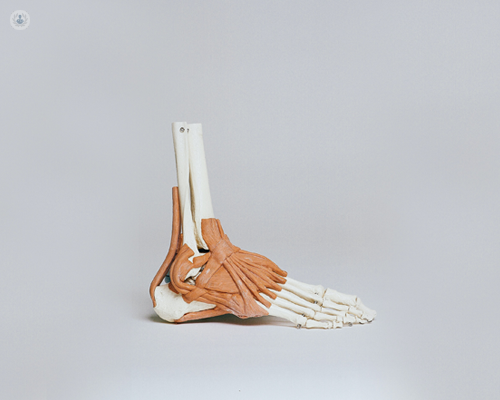Understanding bunion surgery: When, how, and what to expect
Escrito por:Bunion surgery, also known as bunionectomy, is a surgical procedure aimed at correcting a bunion, a bony bump that forms at the base of the big toe. This condition can cause discomfort, pain, and difficulty in walking for many people. We invited esteemed consultant trauma and orthopaedic surgeon Mr Naveed Shaikh to shed light on the indications for bunion surgery, as well as the procedure itself, recovery, and potential outcomes.

What are the indications for bunion surgery?
Bunion surgery is typically recommended when conservative treatments (wide shoes, splints) fail to alleviate the symptoms associated with bunions. These symptoms may include:
- Persistent pain that interferes with daily activities
- Inflammation and swelling around the big toe joint
- Difficulty walking or wearing regular shoes due to the bunion's size or shape
- Deformity or misalignment of the big toe, leading to functional impairment
It's important to consult with a qualified orthopaedic surgeon to determine if bunion surgery is the appropriate course of action based on individual circumstances and severity of symptoms.
How is bunion surgery performed?
Preoperative preparation:
Before undergoing bunion surgery, patients will typically undergo a thorough evaluation, which may include physical examination, imaging tests (such as X-rays), and discussions about medical history and expectations. The surgeon will explain the procedure in detail, discuss potential risks and benefits, and address any concerns the patient may have.
Surgical procedure:
Bunion surgery can be performed using various techniques, depending on the severity of the bunion and the patient's specific needs. The most common types of bunion surgery include:
- Osteotomy: Involves cutting and realigning the bone to correct the deformity (the most common surgery to correct a bunion).
- Exostectomy: Removal of the bony bump without realigning the bone.
- Arthrodesis: Fusion of the affected joint to provide stability and reduce pain (if there is co-existing arthritis).
The surgeon will choose the most appropriate technique based on factors such as the degree of deformity, presence of arthritis, and overall health of the patient.
Postoperative care and recovery:
The surgery is performed under general anaesthesia as day case surgery (the patient goes home the same day). After bunion surgery, patients will typically experience some degree of pain, swelling, and discomfort, which can be managed with pain medications and proper rest. The surgeon may recommend wearing a protective boot to support the foot during the initial stages of recovery. The patient can fully weight bear in the protective boot.
Physical therapy exercises may also be prescribed to improve strength, flexibility, and range of motion in the affected foot. It's essential for patients to follow postoperative instructions carefully and attend follow-up appointments to monitor healing progress and address any concerns. The patient is typically seen two weeks and six weeks after surgery. The bone takes six weeks to heal. Usually, weight bearing is allowed in normal shoes at six weeks.
What are the potential outcomes and associated risks?
While bunion surgery can provide significant relief from pain and improve foot function for many patients, it's important to acknowledge that outcomes can vary depending on individual factors and the chosen surgical approach. Potential outcomes may include:
- Reduction in pain and discomfort associated with the bunion
- Improved alignment and appearance of the big toe
- Enhanced ability to wear regular shoes and engage in physical activities
Like any surgical procedure, bunion surgery carries certain risks and complications, including infection, nerve damage, recurrence of the bunion, clots, chronic pain and prolonged recovery time. Patients should discuss these risks with their surgeon and weigh them against the potential benefits before making a decision.
Bunion surgery is a viable option for those experiencing persistent pain and functional impairment due to bunions. By gaining insight on the indications, procedure, and potential outcomes associated with bunion surgery, you can make informed decisions about your foot health and overall wellbeing. If you're considering bunion surgery, it’s important to consult with a qualified orthopaedic surgeon to explore your options and develop a personalised treatment plan tailored to your needs.
If you are considering bunion surgery and wish to schedule a consultation with Mr Shaikh, visit his Top Doctors profile today.


